It is common when Succulents getting mushy. Succulents are usually known as plants which require easy maintenance. Hence, many people tend to grow succulents in their gardens a lot. These succulents usually grow well if their fundamental requirements are met.
Apart from that, they have a natural mechanism where they can conserve water in their leaves and in stems. This is a specialty among the succulents and that is one of the reasons why they are regarded as easy maintaining plants.
However succulents could also get fuzzy sometimes and will make trouble for you If they are neglected for a longer period.
One such situation is that they tend to become mushy . you could sometimes, even feel its soggy when you try to touch them. If it feels mushy when you try to touch them, it indicates that it is struggling to survive.
This is considered as a common issue which is faced by the succulents plant lovers a lot. There are several reasons which cause the succulents to become mushy along with yellowing.
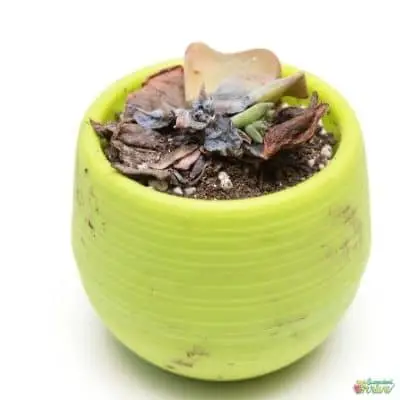
The cause and the prevention method
Overwatering
Succulents most faced issues are water related. Succulents are plants which prefer to grow in heated conditions. Further since they have a natural water conservation system, they do not really like to be over watered.
In case you spot the succulent’s leaves are yellow, try to touch them and see whether they are soggy or mushy. If you feel it that way, undoubtedly it is due to overwatering.
The very first sign the succulents give to indicate that they are overwatered is losing their leaves at a gentle touch. There could be root rots as well.
Afterwards, chances are that little black spots will start appearing on the leaves as well as on the stems. Unfortunately, This will be the time where you cannot do anything to protect your plant irrespective of what you do to save it.

How do you fix Overwatered succulent?
The first thing you can do is to halt watering for a few days. Then, you can realize whether the water has been absorbed. If much water has been absorbed and if the soil is dried enough, you can resume again.
Additionally, you have the option of replanting them in a new pot which contains good drainage . You could replant if there are no root rots on the plant. Moreover, you can add some gravel, pebbles at the base of the new pot which will consequently stimulate better drainage.
However, if you come across any black spots around the stem, following actions should be implemented.
- Firstly, take it out from the pot as well from the soil very cautiously without causing any damage to the plant.
- Secondly trim the area which has the black spots and leave the healthy part for several days until it gets fully dried enough. Ensure that you do not expose it for direct bright sunlight.
- Once the succulent is dried enough, remove the old soil and plant them in a new pot along with a new soil mixture. It must be a well-draining one.
- Ensure that you water them after one weeks’ time from its reporting. Furthermore, be watchful to water those moderately.
We can get the plant to bounce back faster if we identify the succulent has become mushy at the initial stage. Once you cut down on water, we can rescue the plant. On the other hand, if you see any black spots all over the plant , chances are that plant will deteriorate entirely. Ultimately we will lose it.
Underwatering
As stated above, succulent plant have generally a natural mechanism to store much water in the plant. It is not a secret that they could thrive in warm conditions and drought periods.
However it doesn’t mean that they do not require water at all. They would also appreciate a little drink so that they will feel happy. If they get deprived of water , they will try to indicate that in several ways.
In that circumstance, they will show up their leaves in a wrinkled way. That is simply because their water storage is getting finished. You will see how your bottom leaves start to wither initially.
After that, when you try to touch the succulent, you will feel the leaves are mushy. That is because at this point of time, they had lost their firmness and plumpness.
Consider that you witness some roots forming on the stems. If you come across any condition like that, that shows it is running short of water. Literally, underwatering has resulted in turning the succulents yellow.
Though , under watering is less spoken when it comes to succulents, that could also affect the succulents to become mushy.eg- Portulacaria alfa or Senecio haworthii. As soon as you spot the succulent leaves turn yellow, wrinkled, you should start watering them.

How do you fix under watering
If you realize that under watering has factored in your succulent to become mushy, without hesitation start watering them on a regular basis until its requirement gets fulfilled. You can ideally water the plants once a week and let it soak properly.
Underwatering does not mean that we need to over water them. Hence, make sure you use a pot with a good drainage system which will not help to retain water in the pot.
Weather conditions
Weather conditions could also affect in turning the succulents mushy. It is a well known fact that succulents are drought tolerant plants.
Hence, they do not really like the cold temperatures. If they get exposed to cold temperature, succulents will tend to become mushy.
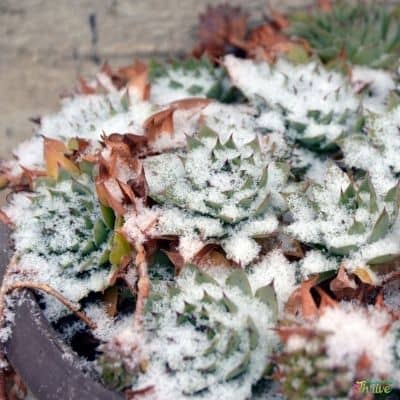
How do you fix Weather conditions
You could move them to an indoor greenhouse to protect them from frost. It could be a porch or a conservatory as well. If you can facilitate this, you can move them to a dry spot near your home. If it is a unheated greenhouse, you could place them on shelves as well
Further you could wrap your succulents with frost cloths / horticultural fleece. When you are using a frost cloth, you could place Christmas light as well which will add warmth to the plant.
If you are using a horticultural fleece , you should use the most suitable one for your plant as it has so many varieties based on the severity of the frost. This will help in withholding the heat within the plant too. Further, it will obstruct the excess rain reaching the plant as well.
As such the plants will be safe from rot as well. Ensure that you cut down on watering during this time.
How do you save a mushy succulent?
If you spot a mushy succulent, make sure that you attend to it at that very moment without delaying. If you are late to identify the issue, there will be more severe repercussions and chances will be very less to save your plant.
You can cut down on water and take necessary steps to wither it.
Once you spot a mushy succulent, the first thing you should do is remove the plant from the existing pot. After that remove the wet soil around the roots as well.
Let it wither for about 3 days or even you can leave it for one week. Place it where it will get bright sunlight. Please do not expose it to direct sunlight as it could be harmful for the plant. After it is withered, repot them in an appropriate pot which has a good drainage.
refrain in watering as soon as you do repotting. Ideally, you have to wait for several days to water it once again. Do not over water again. Please follow the necessary steps when watering the succulent.
Additionally, you do not really have to repot them if they were in the appropriate potting soil mix. Make sure that you let it wither before proceeding with another watering session.
You can ascertain the dryness of the soil simply by observing the top layer of the soil. If you feel its wet, it is recommended to go ahead with reporting for a better outcome.
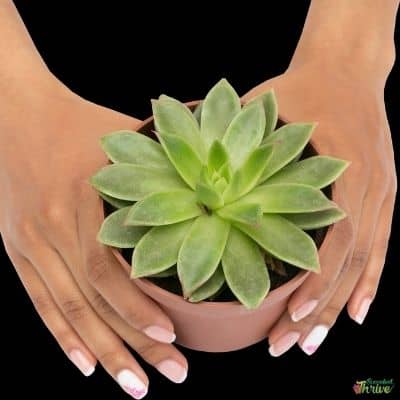
How do you fix soft succulents?
When the succulents are having a healthy growth, they usually have firm and green leaves. Their leaves are somewhat different to other plants. The main reason for that is their ability to conserve water in their leaves.
Succulents turning soft could be an impact of watering and that is an indication they do tell you that they are running out of water. This is commonly spotted among the succulents. If the plants are not getting sufficient water, the leaves will start becoming soft.
Literary, the cells cannot retain water in the leaves and they won’t be able to maintain their thickness due to that. Hence, they will become soft. As a result of this, their healthy tissues will get affected.
One more factor which causes succulent leaves to become soft is the impact of the weather conditions. Succulents are generally adapted to warm conditions and once they get exposed to colder climates the leaves of the succulents will tend to become soft.
You can just give a gentle squeeze for the leaves and feel it whether they are too soft. Secondly If you spot your succulent with its upper leaves wrinkled that is a sign that their leaves are going soft. As soon as you see this, ensure that you water them adequately.
Consider that you have succulent which contains long stalks instead of short leaves. In that scenario, chances are that you could find the stalks fold in half because of softness.
Having said this, please do note that if you wait patiently for some time while adhering to the proper watering process, you will be able to get your healthy plant back.
Prevent Your Succulent Leaves From Turning Soft
1.lightning
You could simply use a grow light for this purpose as they will keep the succulent heated. This is more like we get ourselves covered from a warm blanket to make us feel comfortable during winter times.
Heat map could also be added for this purpose. After that leave, your pot on top of it, so that it could be in its own peace. As a result of this, plants will get the heat from the bottom up.
2.Soil condition
Most importantly, ensure that your potting soil is entirely withered prior to each watering session. This is a known fact among all the succulents plant fans. This literally means, the soil at the base of the pot should also be dry.
3.Drainage pattern
Please do be vigilant on the draining system of the pot as well since it is equally important as the other facts mentioned above. If in case, the draining is not good for the succulent, chances are that solid and it could get soggy. This will lead the plant for a great struggle.
You could be little tricky here as you can use large particles, stones in the pot. This return will make the drainage efficient which will be beneficial for the plants growth. This will obstruct the plant storing water. Not only that but also, it will avoid the plant getting rot as well.
4.Type of the pot
Keep in mind to use the correct type of pot for this purpose as well. It is recommended to utilize a terra cotta pot since they could absorb water. This will also help to avoid the plant in retaining additional water in the soil.
5.Water on the leaves
Moreover keep an eye on the water which gets added on the leaves. This will lead to the succulents leaves to get mushy. You can of course spend some time withering the leaves if you spot any water splash on them after watering.
6.Root health
If you spot your succulent is soft and mushy, go and inspect your succulents roots. In case, you find the succulent roots are not alive, this is the time when you should conduct propagation.
Then you can let a new succulent be born. Having said that, if you think, the roots are healthy and if the soil is dry, never give up on rescuing your plant as you still can do it.
How often should succulents be watered?
All succulent fans know , succulents are hardy plants simply due to the fact that they don’t expect us to water them on a frequent basis. Their natural water conservation mechanism plays a big role here.
Being native in warmer countries has also affected them to be hardy plants. Having said that you have to bear in mind that you need to water them on a moderate level as appropriate.
First thing that comes to our minds when it comes to watering is that you must water the succulents only if its soil is completely dried. To reiterate, don’t ever water the succulents if its soil is not completely dried enough.
It is mandatory and something you should never forget! let them dry before you conduct another watering session. In case you leave your succulents with moist, you will most probably end up with losing the plant. The repercussion is such that it will lead to root rot.
If you want to water your succulent, you must think on four main factors.
Season
Everybody knows that succulents’ growing seasons are spring and summer. Hence , you need to be more aggressive than other seasons when watering them during these times.
When they actively grow during these periods, they utilize plenty of water at a faster rate. That is because they need to form new stems, leaves, roots and for blooming etc. Watering them thrice a week during these times would work well.
Having said that it is based on other factors like light and temperature as well.
Succulents’ dormancy season is winter. They won’t grow well during these periods like they do in spring and in summer. Hence why, you need to cut down on watering during this period as they do not consume water a lot.
Watering them one / two times for the whole season would be adequate. Your plant will end up being dead if you water them too much during winter. Best to leave it to sleep during their dormant season.

Pot size
The pot size is the second factor which affects the watering frequency for the succulents. Consider you have a larger pot, then you better water them less as they have a plenty of soil compared to the smaller pots.
Soil in the larger pot will be stored moist for longer periods. On the other hand, It is the opposite with the small pots, as their draining is faster than the larger pots. Hence you need to water them more than you do for larger pots.
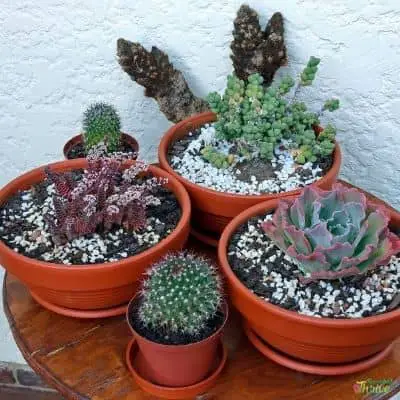
Sunlight
We should concentrate on sunlight also when we think of watering the succulents. Literally the succulents which get more sunlight require more water. Hence, outdoor plants need to be watered more than the indoor plants. This is simply because outdoor plants are exposed for more sunlight as well as for tougher conditions.
Please do bear in mind to water the succulents in high humidity and cooler temperatures less. The plants which are adapted to dry conditions retain water for a longer period. Hence depending on these conditions, change the frequency in watering the succulent.
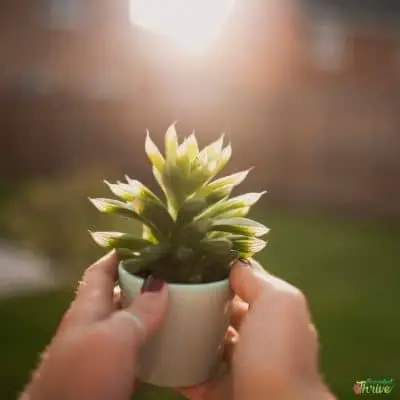
Why are succulent leaves pointing up?
There could be several reasons for the leaves to point upwards. It could either be a result caused by lack of water or getting exposed too much for direct sunlight. Having said that, leaves pointing upwards is a better sign than its pointing down.
One reason for this condition is, shriveling away from direct sunlight. Despite how hard they are for heated and intense temperature conditions, if they get exposed to direct sunlight for a longer period , it will deteriorate the plant.
Be careful with the young baby succulents as you should not expose them for direct sunlight. . If you spot your plants leaves have pointed upwards, you simply must relocate it to a shady place.
Sometimes, it could be natural also for the leaves to point upwards. Then you can neglect that as it is natural. A succulent like Aloe Vera is a great example for this as they get their leaves naturally pointed up.
If succulents are running short of enough water , the leaves will tend to get pointed up too. Chances are that it could get wrinkled too.
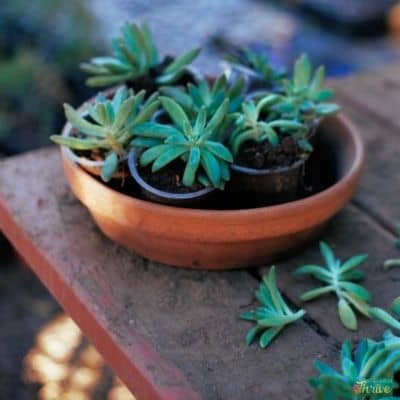
Should I remove yellow / dead leaves from succulents?
Succulents are regarded as easy to maintain plants. Nevertheless, if they do not get their requirements fulfilled, they will start to turn their leaves yellow.
You are encouraged to take out any dead leaves from the plant as well as from the soil. So that insects and bugs cannot survive there.
Credit to : Ken-Ken De Lara
